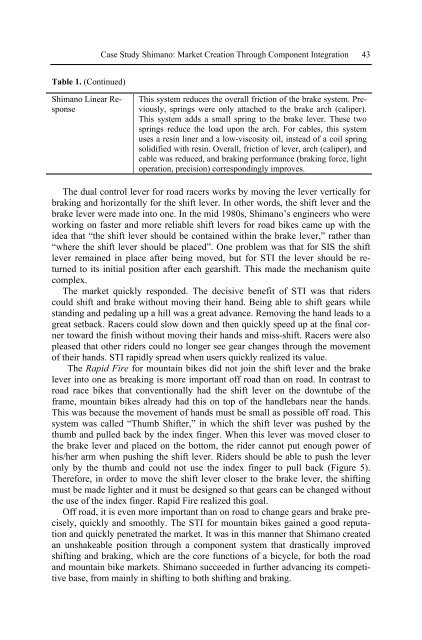Management of Technology and Innovation in Japan
Management of Technology and Innovation in Japan
Management of Technology and Innovation in Japan
Create successful ePaper yourself
Turn your PDF publications into a flip-book with our unique Google optimized e-Paper software.
Table 1. (Cont<strong>in</strong>ued)<br />
Shimano L<strong>in</strong>ear Response<br />
Case Study Shimano: Market Creation Through Component Integration 43<br />
This system reduces the overall friction <strong>of</strong> the brake system. Previously,<br />
spr<strong>in</strong>gs were only attached to the brake arch (caliper).<br />
This system adds a small spr<strong>in</strong>g to the brake lever. These two<br />
spr<strong>in</strong>gs reduce the load upon the arch. For cables, this system<br />
uses a res<strong>in</strong> l<strong>in</strong>er <strong>and</strong> a low-viscosity oil, <strong>in</strong>stead <strong>of</strong> a coil spr<strong>in</strong>g<br />
solidified with res<strong>in</strong>. Overall, friction <strong>of</strong> lever, arch (caliper), <strong>and</strong><br />
cable was reduced, <strong>and</strong> brak<strong>in</strong>g performance (brak<strong>in</strong>g force, light<br />
operation, precision) correspond<strong>in</strong>gly improves.<br />
The dual control lever for road racers works by mov<strong>in</strong>g the lever vertically for<br />
brak<strong>in</strong>g <strong>and</strong> horizontally for the shift lever. In other words, the shift lever <strong>and</strong> the<br />
brake lever were made <strong>in</strong>to one. In the mid 1980s, Shimano’s eng<strong>in</strong>eers who were<br />
work<strong>in</strong>g on faster <strong>and</strong> more reliable shift levers for road bikes came up with the<br />
idea that “the shift lever should be conta<strong>in</strong>ed with<strong>in</strong> the brake lever,” rather than<br />
“where the shift lever should be placed”. One problem was that for SIS the shift<br />
lever rema<strong>in</strong>ed <strong>in</strong> place after be<strong>in</strong>g moved, but for STI the lever should be returned<br />
to its <strong>in</strong>itial position after each gearshift. This made the mechanism quite<br />
complex.<br />
The market quickly responded. The decisive benefit <strong>of</strong> STI was that riders<br />
could shift <strong>and</strong> brake without mov<strong>in</strong>g their h<strong>and</strong>. Be<strong>in</strong>g able to shift gears while<br />
st<strong>and</strong><strong>in</strong>g <strong>and</strong> pedal<strong>in</strong>g up a hill was a great advance. Remov<strong>in</strong>g the h<strong>and</strong> leads to a<br />
great setback. Racers could slow down <strong>and</strong> then quickly speed up at the f<strong>in</strong>al corner<br />
toward the f<strong>in</strong>ish without mov<strong>in</strong>g their h<strong>and</strong>s <strong>and</strong> miss-shift. Racers were also<br />
pleased that other riders could no longer see gear changes through the movement<br />
<strong>of</strong> their h<strong>and</strong>s. STI rapidly spread when users quickly realized its value.<br />
The Rapid Fire for mounta<strong>in</strong> bikes did not jo<strong>in</strong> the shift lever <strong>and</strong> the brake<br />
lever <strong>in</strong>to one as break<strong>in</strong>g is more important <strong>of</strong>f road than on road. In contrast to<br />
road race bikes that conventionally had the shift lever on the downtube <strong>of</strong> the<br />
frame, mounta<strong>in</strong> bikes already had this on top <strong>of</strong> the h<strong>and</strong>lebars near the h<strong>and</strong>s.<br />
This was because the movement <strong>of</strong> h<strong>and</strong>s must be small as possible <strong>of</strong>f road. This<br />
system was called “Thumb Shifter,” <strong>in</strong> which the shift lever was pushed by the<br />
thumb <strong>and</strong> pulled back by the <strong>in</strong>dex f<strong>in</strong>ger. When this lever was moved closer to<br />
the brake lever <strong>and</strong> placed on the bottom, the rider cannot put enough power <strong>of</strong><br />
his/her arm when push<strong>in</strong>g the shift lever. Riders should be able to push the lever<br />
only by the thumb <strong>and</strong> could not use the <strong>in</strong>dex f<strong>in</strong>ger to pull back (Figure 5).<br />
Therefore, <strong>in</strong> order to move the shift lever closer to the brake lever, the shift<strong>in</strong>g<br />
must be made lighter <strong>and</strong> it must be designed so that gears can be changed without<br />
the use <strong>of</strong> the <strong>in</strong>dex f<strong>in</strong>ger. Rapid Fire realized this goal.<br />
Off road, it is even more important than on road to change gears <strong>and</strong> brake precisely,<br />
quickly <strong>and</strong> smoothly. The STI for mounta<strong>in</strong> bikes ga<strong>in</strong>ed a good reputation<br />
<strong>and</strong> quickly penetrated the market. It was <strong>in</strong> this manner that Shimano created<br />
an unshakeable position through a component system that drastically improved<br />
shift<strong>in</strong>g <strong>and</strong> brak<strong>in</strong>g, which are the core functions <strong>of</strong> a bicycle, for both the road<br />
<strong>and</strong> mounta<strong>in</strong> bike markets. Shimano succeeded <strong>in</strong> further advanc<strong>in</strong>g its competitive<br />
base, from ma<strong>in</strong>ly <strong>in</strong> shift<strong>in</strong>g to both shift<strong>in</strong>g <strong>and</strong> brak<strong>in</strong>g.


